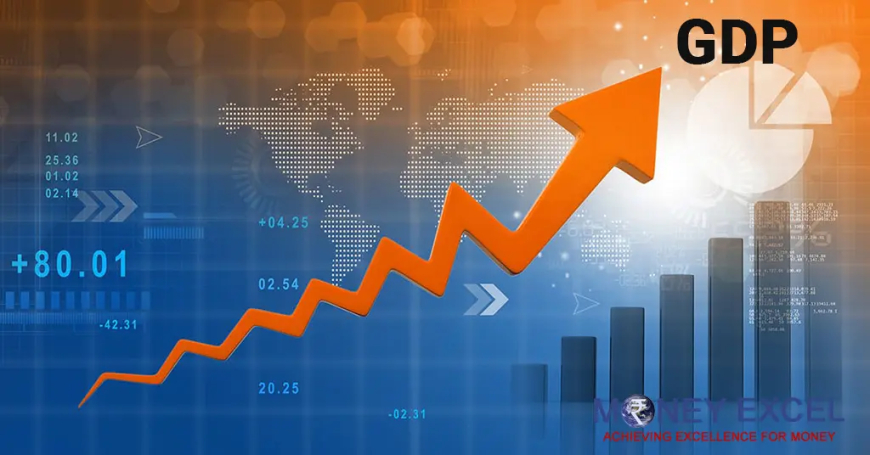India’s Economic Momentum: Decoding the GDP Growth and Future Outlook in 2025
India’s GDP growth in 2025 shows strong economic momentum despite global challenges. Explore detailed insights, policy shifts, and sectoral trends shaping India’s economic outlook.

India’s GDP Growth and Economic Outlook in 2025: A Comprehensive Review
India has entered 2025 with renewed economic vigor, defying global slowdowns and emerging as one of the fastest-growing major economies in the world. With a projected GDP growth rate of 6.8% to 7.1%, India is not just bouncing back post-pandemic — it’s positioning itself as a global economic powerhouse.
This article provides a detailed analysis of India’s GDP growth trends, contributing sectors, policy drivers, and economic challenges — all shaped by recent government reforms, infrastructure investments, and global economic alignments.
A Snapshot of India’s GDP Growth Trajectory
According to the Ministry of Finance, India’s economy expanded by 7.6% in FY 2023-24, exceeding both IMF and World Bank projections. The momentum has been carried into 2025 due to strong domestic demand, robust manufacturing performance, and consistent government capital expenditure.
The International Monetary Fund (IMF) projects India to contribute nearly 15% to global growth in 2025, second only to China. This positions India as a stabilizing force in a volatile global economy marked by inflationary pressures and geopolitical tensions.
Key Growth Drivers in 2025
1. Manufacturing and Exports
Under the Production-Linked Incentive (PLI) scheme, India's manufacturing sector saw a revival, particularly in electronics, automotive, and pharmaceuticals. Companies like Foxconn and Samsung have expanded their manufacturing bases in India, boosting employment and exports.
2. Digital Economy and Startups
India’s digital infrastructure is powering a new economic engine. According to Invest India, the digital economy is projected to contribute 20% to India’s GDP by 2027, up from 7.5% in 2021. Fintech, edtech, and healthtech startups are receiving both domestic and international investments, reinforcing the country’s innovation ecosystem.
3. Government Capital Expenditure
Public investment in infrastructure is at an all-time high. The Union Budget 2024-25 allocated INR 11.1 lakh crore for capital expenditure — a 33% increase from the previous year. Projects in railways, highways, and green energy are not only stimulating growth but also enhancing long-term productivity.
Read more about this in the official Budget Highlights released by the Government of India.
Sectoral Insights: What’s Driving the Economy?
| Sector | Contribution to GDP (2025 est.) | Growth Rate |
|---|---|---|
| Services | 53% | 7.3% |
| Industry | 26% | 6.5% |
| Agriculture | 14% | 3.8% |
| Digital Economy | 7% | 17% |
Services Sector: India’s services sector, especially IT and financial services, continues to be the backbone of GDP growth. Firms like Infosys and TCS are expanding their global footprints while investing heavily in AI and cloud services.
Agriculture: Despite a declining share in GDP, the agriculture sector remains vital, especially for rural employment. The adoption of agri-tech platforms and smart irrigation systems is improving productivity and resilience against climate challenges.
Monetary and Fiscal Policy Landscape
India’s economic policy in 2025 is characterized by fiscal prudence and targeted welfare. The Reserve Bank of India (RBI) has maintained a repo rate of 6.5%, focusing on price stability while ensuring adequate liquidity in the system.
On the fiscal front, the government aims to reduce the fiscal deficit to 5.1% of GDP, maintaining credibility while continuing productive spending. Read the latest updates from the RBI Bulletin.
External Trade and Global Integration
India's trade relations have been expanding, especially with countries like the UAE, Australia, and Japan. The India-UAE CEPA (Comprehensive Economic Partnership Agreement) and India-Australia ECTA have provided significant boosts to exports in textiles, pharmaceuticals, and engineering goods.
In FY 2024-25, India’s merchandise exports are expected to reach USD 480 billion, according to EXIM Bank of India, despite global trade headwinds.
Challenges and Risks Ahead
While the outlook is optimistic, several structural challenges need attention:
-
High youth unemployment despite economic growth.
-
Urban inflation impacting middle-income consumption.
-
Climate change causing agrarian distress and water shortages.
-
Banking sector NPA stress in smaller banks and NBFCs.
Tackling these requires sustained policy reform, inclusive growth strategies, and digital financial literacy campaigns.
What Experts Are Saying
"India is at an inflection point where macroeconomic stability aligns with entrepreneurial dynamism. If the momentum continues, we could see India becoming a USD 5 trillion economy by 2028."
— Dr. Raghuram Rajan, former RBI Governor
"Our projections show that India could become the world's third-largest economy by 2027, surpassing Germany and Japan."
— S&P Global Report (2025) [source]
Future Outlook: Where Is India Headed?
India’s economic outlook in 2025 is cautiously optimistic. The government’s twin focus on infrastructure and innovation is creating a growth-ready ecosystem. If supported by consistent reforms in labor laws, ease of doing business, and digital governance, India is likely to sustain a 6.5–7% GDP growth rate over the next five years.
The long-term vision hinges on sustainable development, green energy adoption, and ensuring inclusive digital access to all socio-economic classes.
Final Thoughts
India’s GDP growth in 2025 is not just a number — it reflects a deeper structural shift. With global supply chains being reimagined and emerging technologies being adopted at scale, India has a genuine opportunity to rise as a global economic leader. But seizing this opportunity requires continued policy agility, inclusive planning, and innovation at every level.
To explore more about India’s development trends and economic policies, follow real-time updates on NITI Aayog’s portal and Economic Times Economy News.


















































